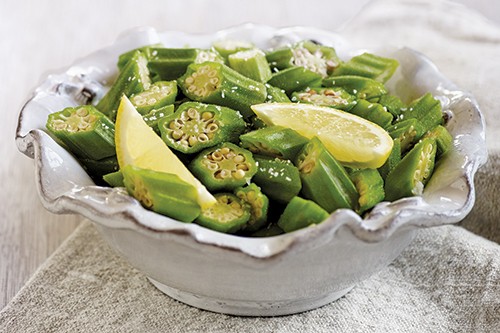
Native to Africa, okra was first brought to the U.S. by Ethiopian slaves. Now available in the U.S., Africa, Asia and the Middle East, all parts of the okra plant — pods, leaves and seeds — are edible. Fresh pods are most tender when they're two- to three-inches long. Green okra is most common, but it is also available in red and purple, in up to 20 different varieties.
Fresh okra is available from about May through October, but supermarkets carry frozen okra year-round. Okra shines in gumbo where its viscosity naturally thickens the stew. Left whole, okra is often crisp and tender when it's quickly cooked by grilling, frying, stir-frying or roasting. Sliced fresh okra, pressure cooked for just one minute, has a pleasant crunch. Okra becomes stickier the longer it sits after cutting or cooking.
Okra's mild flavor acts as a backdrop for herbs, spices and citrus. Okra is used frequently in Indian bhindi curries and is equally as good in African curries. Whole pods can be pickled in vinegar for a tasty snack. Quickly cooked okra can substitute for nopal cactus in traditional Mexican dishes, flavored with lime and cilantro.
Okra's Nutritional Benefits
Okra is one of the world's most widely grown vegetables, although it is less common in the U.S. The Abelmoschus esculentus plant is in the mallow family and is related to hibiscus.
Like many vegetables, okra is low in calories, with just 35 calories per cup, cooked. Okra is rich in vitamin C and a good source of folate and calcium. It also contains significant amounts of vitamin K and potassium. With four grams of fiber per cup, mostly soluble — as evidenced by its sticky quality — okra has similar potential health benefits to beans, barley, oats and apples. Okra contains the antioxidants lutein and zeaxanthin, two especially important carotenoids related to vision health.
Okra has been used traditionally in home remedies for many ailments; however, there is insufficient information about its effectiveness. Animal studies show potential for okra's beneficial effects on brain health, blood sugar and cholesterol management. Further studies are needed to determine whether it has the same effects in humans.
Cooking Okra in Quantity
Summer menus, especially in the South, often feature fresh okra. Other menus throughout the U.S. feature okra year-round because it can be purchased frozen in several forms: whole, sliced, breaded, heavily breaded or breaded with Cajun seasoning. Package sizes range from two to 25 pounds, and are available in a variety of case packs. Okra can remain frozen for up to 24 months. Make only what you will use quickly, as okra is not a vegetable that tastes better as it ages.
Okra is a key ingredient in gumbo, which is thought to get its name from the West African Bantu word for okra, ki ngombo. This flavorful Creole stew is a New Orleans specialty that can be created from a wide variety of ingredients.
Tomatoes and okra are a great pairing, and some cooks like to add other vegetables such as onion, corn or beans.
Because of okra's stickiness, cornmeal adheres to defrosted whole or sliced frozen vegetables, allowing for a healthier baked version on the menu. Whole pods also can be quickly steamed and seasoned. Lightly oiling and seasoning whole okra and roasting it on a sheet pan yields a tasty, simple dish.
Jill Nussinow, MS, RD, is the author of The Veggie Queen: Vegetables Get the Royal Treatment and The New Fast Food: The Veggie Queen Pressure Cooks Whole Food Meals in Less than 30 Minutes.
Simply Steamed Okra
Developed by Oldways’ A Taste of African Heritage Program
Ingredients
1 pound fresh or frozen whole young okra pods
1 cup water
1/4 of a lemon, juiced
Pinch of salt
Directions
- Rinse the okra thoroughly in cold water. Place okra into steaming basket over boiling water. Cover
- and cook until tender but crisp, about five minutes.
- Toss with lemon juice and salt. Serve warm.
Nutritional Info
Serves 4
Serving size: 1/2 cup
Calories: 38
Total Fat: 0g; Sat. Fat: 0g
Chol.: 0mg; Sodium: 8mg
Carb.: 8g; Fiber: 3.5g; Sugars: 2g
Protein: 2g; Potassium: 342mg; Phosphorus: 69mg
For more Oldways recipes, visit OldWayspt.org. Used with permission.
Green and Red Bean African Curry with Okra
Developed by Jill Nussinow
Ingredients
1 tablespoon olive oil
1 large onion, finely chopped
2 tsp. ginger, minced
3 large cloves garlic, minced
1 tsp. ground coriander
1 tsp. ground turmeric
1 tsp. ground cumin
Pinch of yellow mustard powder or seeds
Pinch of ground cardamom
Pinch of cayenne
1 1/2 cups cooked kidney or other red beans
3 whole bay leaves
1 pound fresh green beans, cut into 2-inch pieces
1/2 cup vegetable broth
1 cup chopped okra, fresh or frozen
2 large fresh tomatoes, chopped (or 15-ounce can diced tomatoes, drained)
2 tsp. tomato paste
2 tsp. fresh lemon juice
1/2 tsp. salt
1/4 tsp. ground black pepper
2 Tbsp. chopped fresh cilantro
Directions
- Heat olive oil in large skillet over medium heat. Add onion and sauté for a minute or two; add ginger and garlic and stir.
- Add coriander, turmeric, cumin, mustard, cardamom and cayenne; sauté another minute.
- Add kidney beans, bay leaves, green beans and vegetable broth; simmer for five minutes.
- Add okra and tomatoes; cook another five minutes until green beans are bright green and still crisp-tender.
- Quickly stir in tomato paste and lemon juice; simmer one more minute. Taste and adjust seasonings, adding salt and pepper as needed.
- Serve hot, garnished with cilantro.
Nutritional Info
Serves 6
Serving size: 1 cup
Calories: 136
Total Fat: 3g; Sat. Fat: 0.5g
Chol.: 0mg; Sodium: 264mg
Carb.: 23g; Fiber: 7g; Sugars: 6g
Protein: 6g; Potassium: 618mg; Phosphorus: 130mg
Adapted from The New Fast Food: The Veggie Queen Pressure Cooks Whole Food Meals in Less than 30 Minutes (Vegetarian Connection Press 2011) by Jill Nussinow, MS, RD.
